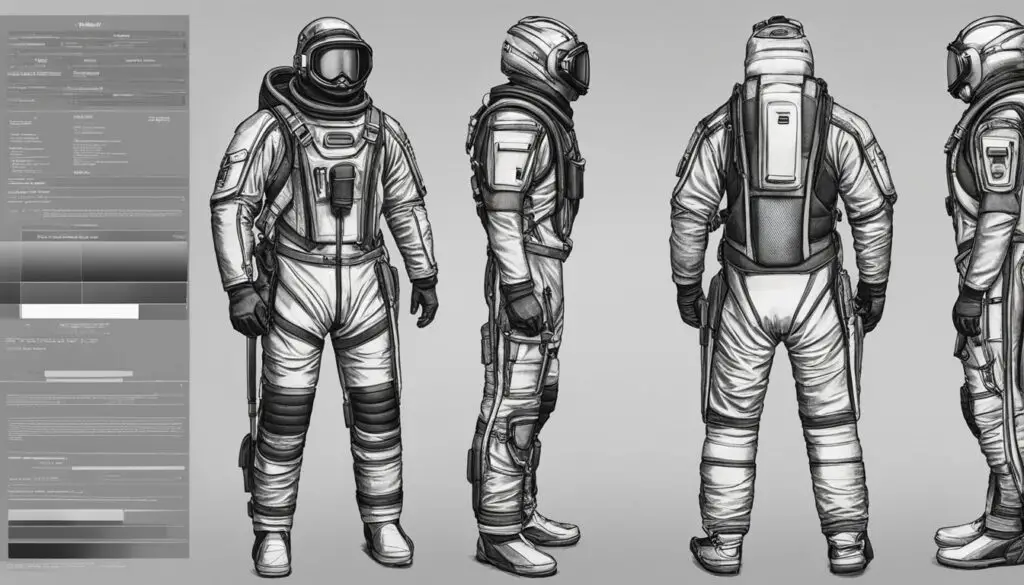Underwater diving is an exhilarating experience that opens up a whole new world of exploration beneath the surface. Whether you’re a seasoned diver or just starting out, having the right equipment is crucial for a safe and enjoyable dive. In this guide, I will take you through the essential diving gear you need to make your underwater adventures unforgettable.
Key Takeaways:
- Underwater diving equipment is essential for a safe and enjoyable diving experience.
- Scuba tanks provide a constant supply of oxygen underwater and require proper maintenance.
- Dive suits such as wetsuits and drysuits offer thermal protection against cold temperatures.
- Fins enhance maneuverability and propulsion underwater, with different types to suit various conditions.
- Dive masks are essential for clear vision underwater and should be chosen based on fit and visibility.
Scuba Tanks: Your Lifeline Underwater
Scuba tanks are an essential piece of equipment for any diver. These portable containers hold compressed air, providing divers with a steady supply of oxygen while underwater. Being well-informed about scuba tanks ensures you select the right one for your diving needs, allowing you to explore the depths with confidence.
When choosing a scuba tank, several factors should be considered. First, tank size plays a crucial role in determining your dive duration. Larger tanks contain more air and can provide longer dive times, while smaller tanks are more compact and lightweight, making them suitable for shorter dives or travel.
The material of the scuba tank is also important. Most modern tanks are made from aluminum or steel, each with its own advantages. Aluminum tanks are lighter and more buoyant, making them easier to transport and suitable for divers who prefer a neutral or positive buoyancy. On the other hand, steel tanks are more durable and negatively buoyant, which can help balance out overall buoyancy when wearing additional equipment or diving in currents.
The type of valve is another factor to consider. There are two common types: the K-valve and the DIN valve. The K-valve is the most prevalent and is compatible with most standard regulators. The DIN valve, on the other hand, provides a more secure and reliable connection, making it popular among technical divers and those using higher pressures.
Proper maintenance and handling of scuba tanks are essential for their safety and longevity. Regular inspections and visual checks for any signs of damage or corrosion should be performed. Additionally, ensuring the tank is properly filled with clean, dry air from a reliable source is crucial for a safe dive.
“The scuba tank is like your lifeline underwater, providing you with the air supply needed to explore the mesmerizing depths of the ocean.”
The Dive Suit: Protection Against the Elements
A dive suit is an essential piece of equipment for every diver, providing crucial protection against the elements and ensuring thermal insulation in cold underwater temperatures. There are two main types of dive suits: wetsuits and drysuits, each offering unique benefits to suit different diving conditions and individual preferences.
1. Wetsuits
Wetsuits are made from neoprene material, a synthetic rubber that provides excellent thermal protection. The design of wetsuits allows a thin layer of water to enter between the suit and the diver’s skin. This water layer is warmed by the body heat and acts as an insulating barrier against the cold water outside. The trapped water provides thermal protection, keeping the diver warm during their underwater adventures.
Wetsuits are highly versatile and come in various thicknesses, allowing divers to choose the suit that matches the water temperature of their diving location. Thicker wetsuits offer more insulation for colder water, while thinner suits provide more flexibility and comfort for warmer water environments.
2. Drysuits
Drysuits, as the name suggests, keep the diver completely dry by sealing out water. They are typically made from a waterproof material such as trilaminate or crushed neoprene and require the use of additional insulation layers, such as undersuits, to provide thermal protection.
Unlike wetsuits, drysuits do not allow water to penetrate, making them suitable for diving in extremely cold water or situations where the diver wants to stay dry. Drysuits have built-in seals at the neck and wrists to prevent water from entering, and divers wear dry gloves or mitts to keep their hands dry.
Choosing the Right Dive Suit
When selecting a dive suit, divers should consider factors such as water temperature, diving conditions, and personal preferences. Here are some points to keep in mind:
- Water temperature: Choose a wetsuit or drysuit that provides the appropriate level of insulation for the water temperature you will be diving in.
- Diving conditions: If you anticipate diving in cold water or in rough conditions where staying dry is important, a drysuit might be the better option.
- Fit and comfort: The suit should fit snugly but not restrict movement. Be sure to try on different sizes and styles to find the one that offers the best fit and comfort for your body shape.
- Durability: Consider the durability of the dive suit material, especially if you plan to dive frequently or in harsh environments.
By carefully considering these factors, divers can choose the dive suit that provides the necessary protection and thermal insulation for a comfortable and safe underwater experience.

Fins: Enhancing Maneuverability Underwater
Fins play a crucial role in underwater diving, providing enhanced maneuverability and propulsion. They are an essential piece of equipment and come in various types, each offering unique advantages and suitable for different diving conditions and preferences.
Fin Types
There are several types of diving fins available, including:
- Full-Foot Fins
- Open-Heel Fins
Full-foot fins are designed to be worn barefoot and are ideal for warm water diving. They are lightweight and provide excellent maneuverability. These fins are popular among snorkelers and divers who prefer a more natural feel while in the water.
On the other hand, open-heel fins are designed to be worn with dive boots and provide a more secure fit. This type of fin is versatile and suitable for various water temperatures and diving conditions. Open-heel fins offer the advantage of being adjustable, allowing divers to achieve a more comfortable fit by adjusting the straps.
Choosing the Right Fins
The choice of fins depends on several factors:
- Diving Style: Different diving styles may require specific fin characteristics. For example, recreational divers may prefer fins that prioritize comfort and ease of use, while technical divers may opt for fins that offer maximum propulsion and stability.
- Water Conditions: The water temperature, current strength, and visibility play a significant role in fin selection. Divers in warm water environments may opt for lighter and more flexible fins, while those in colder waters may require sturdier fins that offer better insulation.
- Personal Preference: Every diver is unique, with individual preferences and comfort levels. Trying out different fin types and styles can help determine which fins provide the best fit and overall comfort for each individual.
By carefully considering these factors and trying out different fin types, divers can select the fins that best suit their specific needs and enhance their maneuverability underwater.

| Fin Type | Advantages | Suitable For |
|---|---|---|
| Full-Foot Fins | – Lightweight and maneuverable – Ideal for warm water diving – Natural barefoot feel | – Snorkelers – Warm water divers |
| Open-Heel Fins | – Adjustable for a secure fit – Versatile for various water conditions – Can be worn with dive boots | – Divers in different water temperatures and diving conditions |
Dive Masks: Clear Vision Below the Surface
A dive mask is an essential piece of equipment that allows divers to see clearly underwater. It creates an air pocket in front of the eyes, enabling clear vision while keeping water out. When choosing a dive mask, factors such as fit, comfort, and visibility are crucial. Different mask features, such as tempered glass lenses, low-volume design, and adjustable straps, contribute to a comfortable and efficient diving experience.
Tempered glass lenses are a common feature in dive masks, providing durability and resisting scratches. This ensures that the mask’s lenses remain clear for optimal visibility underwater. Additionally, some dive masks feature specially coated lenses that enhance underwater colors, allowing divers to experience the vibrant marine life in all its glory.
The low-volume design of a dive mask refers to its ability to reduce the amount of air space inside the mask. This feature helps in clearing the mask and equalizing pressure while diving. A low-volume design also minimizes drag and makes it easier to maneuver underwater.
In terms of fit and comfort, it is essential to choose a dive mask that seals properly against the face, ensuring a watertight fit. Silicone skirts are commonly used for creating a comfortable seal and preventing water from entering the mask. Adjustable straps allow divers to customize the fit according to their preferences, ensuring a snug yet comfortable experience.
“A good dive mask with the right features can significantly enhance underwater visibility and make the diving experience more enjoyable.”
Conclusion
Exploring the underwater world is an exhilarating experience that requires the right diving equipment. From scuba tanks to fins, each piece of gear plays a crucial role in ensuring your safety, comfort, and enjoyment in the depths below. By selecting the essential gear outlined in this dive equipment guide, you can enhance your underwater adventures and create unforgettable memories.
Remember, diving safety should always be your top priority. It is imperative to choose the right equipment based on your individual needs and diving conditions. Prioritize regular equipment checks, proper maintenance, and adherence to safety guidelines to ensure a safe and enjoyable diving experience.
Whether you are a novice diver or a seasoned pro, the right underwater diving equipment can make all the difference. So, equip yourself with the essential gear, dive in with confidence, and let the underwater world mesmerize you.
FAQ
What is the purpose of a scuba tank?
A scuba tank is a portable container that holds compressed air, providing divers with a steady supply of oxygen while underwater.
How do I choose the right scuba tank?
When choosing a scuba tank, consider factors such as tank size, material, and the type of valve. It is also important to prioritize regular maintenance and proper handling for safety and longevity.
What are the two main types of dive suits?
The two main types of dive suits are wetsuits and drysuits. Wetsuits provide thermal protection by trapping a layer of water against the skin, while drysuits keep the diver completely dry by sealing out water and usually require additional insulation layers.
What factors should I consider when choosing a dive suit?
When choosing a dive suit, consider factors such as water temperature, diving conditions, and personal preference to ensure the right level of thermal protection and comfort.
What is the purpose of fins in underwater diving?
Fins are essential for enhancing maneuverability and propulsion underwater. They come in various types, such as full-foot and open-heel fins, which are selected based on factors like diving style, water conditions, and personal preference.
What is a dive mask used for?
A dive mask creates an air pocket in front of the eyes, allowing clear vision while keeping water out. It is an essential piece of equipment for underwater diving, and factors such as fit, comfort, and visibility should be considered when choosing a dive mask.
How can I enhance my underwater diving experience?
To enhance your underwater diving experience, it is important to select the right diving equipment based on your individual needs and diving conditions. Prioritize safety, proper maintenance, and regular equipment checks to ensure a safe and enjoyable diving experience.
